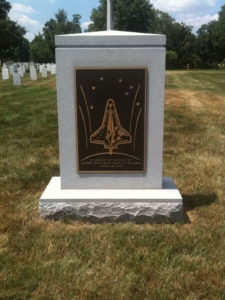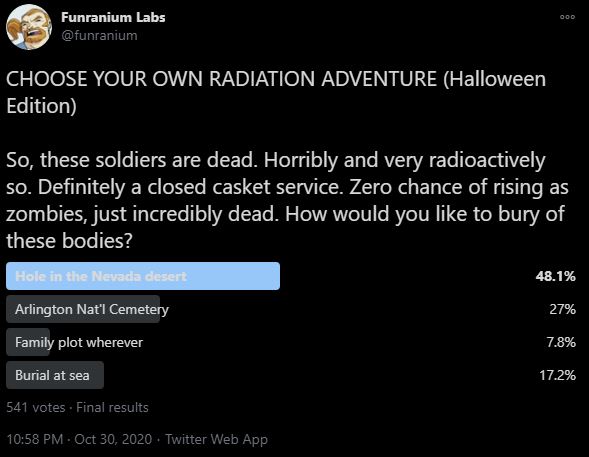To reiterate, the good news here is zero chance of zombies.
The bad news is that you have to cope with the living instead. Unlike the shambling dead, who are fairly goal oriented (re: your brains), the living have Opinions™ and they are often contradictory.
[The twelfth in an ongoing series of my compiled explainers for my CHOOSE YOUR OWN RADIATION ADVENTURE quizzes. There’s never really a right answer but some might work out better under the constraints of the scenario. It’s like poetry, really.]
If anyone’s ever said an anthropology degree is useless, they’re dead wrong.
As humorous anecdote, I was once introduced to the head of the back of the house at a funeral home who was shocked I’d shake their hand. Friend then explained to their boss that I handled plutonium for a living. Boss then had to run off and go wash their hands. Rad workers are unclean to death workers, yo.
But back to handling the dead, depending on religious preferences in question, you may be on a very tight clock. If, for example, you’ve got three days to get that body in the ground that’s not allowing much cool down time for short-lived, particularly nasty radionuclides. As for anointing the body before burial, I had a lot of fun contemplating making lead shielded PPE vestments for my friend @lukei4655 who is a Dominican priest or, in the case of particularly nasty radioactive death, possibly the Blessed Hot Cell for manipulator arm anointing. Other funerary practices, such as unmarked simple burial, would otherwise normally be considered illegal disposal of radioactive waste, kind of like sending the interns/privates to go bury drums “somewhere out on the reservation” without actually noting where you did it.
Cremation would look a lot like waste incineration, as discussed in a previous CYORA, except cremation retorts don’t have that kind of filtration. However, it certainly does reduce the body to a much more manageable size for high level radioactive waste disposal. Your urn in this case would probably be a small Type B container.
Where the Reg Set 1 vs. 2 fight is really going to come down to it is public dose consideration. If your body, after processing and burial, is still a public dose hazard such that anyone near the remains could receive a dose in excess of .02mSv in an hour from them, Reg Set 1 will win. People operating under Reg Set 1, will want a “burial” that is more in accordance with waste disposal concerns, i.e. a hole in the ground in one of the waste burial areas at NTS (no, I will not use it’s current name). You can offer it, but the family doesn’t have to accept.

Which means if you’re going to have a burial somewhere else and The Dose Rate of the Dead is too high, you now have to do some work to insure that the people wandering through the cemetery, especially those that work there, are safe. As these are dead soldiers, in America you have a bonus option: Arlington National Cemetery. If you die in good standing with Department of Defense, you may request burial in Arlington or any open and available military cemetary. Circumstances likely to create several dead very radioactive soldiers might also merit group burial with a handsome memorial, like the USS Thresher, USS Scorpion, and Challenger. While you can request it, DOD can never demand it though they might hint VERY FORCEFULLY that they’d like to do interment at a national cemetery. A group memorial would be very convenient to build a single shielded vault with monitoring to hold the remains of the unlucky crew.
As a bonus military option, if you were either active duty or closely associated with the Navy you can do burial at sea. There is, however, the minor issue that this *might* constitute a violation of the London Convention of Sea Disposal of Radioactive Waste. Burial at sea regs for various nations already specifies specific locations you can do it and also requires that you make sure that the body sinks promptly. Because no one is happy for a body to float ashore, especially a radioactive one. Also, are human remains waste? Oops, you just ended up on the news again with grieving family members for being a heartless bastard again, because you referred to their loved ones as “waste”. This is very tricky territory.
But what if the cemetery has to be moved? Now you have all the family issues of disinterment combined with, well, let’s call them legacy waste issues. The only way I can think to make it more ugly is if it was a tribal burial ground too, like in this documentary Poltergiest.
In the inspiring events for this scenario, we kinda sorta killed three people with reactor oops. You may review the SL-1 incident here. There’s a 3hr version somewhere, but I can’t find it:
For the three victims, the answer was everything but burial at sea, despite the fact that one of them was a sailor and their family, theoretically, could have requested it.
Hopefully that isn’t going to happen again anytime soon.
~fin~
ADDENDUM: to everyone that thinks the technocratic Reg Set 1 should and will always win in a fight with cultural/religious Reg Set 2, which feel like a “nice to have” in your opinion, I’d just like to remind you that the underpinnings of Reg Set 2 have been around a lot longer. They tend to win.
